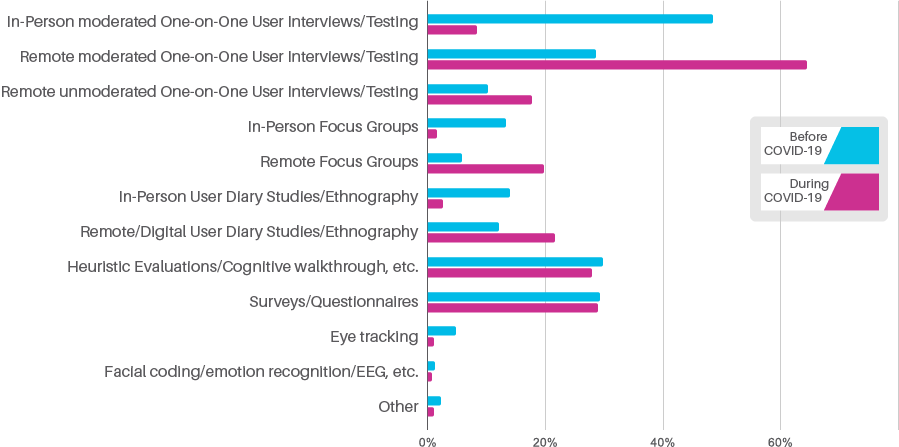There’s no doubt in anyone’s mind that the COVID-19 pandemic has transformed user experience (UX) research. However, a deeper question requires an answer as well: how has the pandemic impacted the future of UX research? I wanted to understand not only how our industry had to adapt, but also catch a glimpse at what the lasting changes might be. Comparing how we worked two years ago with what we’re doing now, how have we been changed? And perhaps more interestingly, what will we doing two years from now?
It would be easy to do a ‘thought piece’ and try to predict the future, but none of us has a crystal ball. Collectively, however, perhaps we can compare with the past and also peer over the horizon. In September 2021 we launched a survey on social media (predominantly LinkedIn) asking UX researchers questions about how their work has changed because of the pandemic. We received over 100 responses. We wanted to listen primarily to those who were doing UX research for the majority of their time (i.e., not UI/UX design or UI programming), and those who had been engaged in UX research prior to the pandemic. Everyone in the sample had three or more years of experience (with more than 50% having more than six years’ experience). Seventy-five percent of respondents had a team reporting to them.
Survey demographics
In the end, we whittled the feedback down to 63 respondents from 22 countries, who represented UX research from in-house, agency, and government environments. From their responses, we found that the effects of the pandemic impacted four aspects of the industry: the demand for UX research, the size of the research team, a change in methods, and the increase in UX research skills.

The demand for UX research increased during the pandemic
After an initial lull, 59% saw an increase in interest in UX research; only 5% saw a decrease in interest. Furthermore, more than 60% of the respondents found that the pace of research was faster during the pandemic than prior to the pandemic; only 7% thought UX research was slower.

This is brilliant news for the industry, but what drove this change? The pandemic forced the world the learn new ways of going to work, interacting with healthcare, buying groceries, and other day-to-day aspects of life that required a rapid and large-scale “digitalization” of products and services. To this point, it was no longer primarily UX researchers demanding testing, but company leadership as well. To quote a respondent from Sri Lanka, “Consumer-facing processes that were completed physically are now forced to go online due to the restrictions of the pandemic. Thus, more companies are looking to develop digital platforms, and tackle the UX/CX problems that arise with it.” In short, the change brought about by the pandemic accelerated need for UX research.
UX research team headcount increased
Coupled with the increase in demand, many respondents reported a growth in the headcount of their teams. 45% reported increased net headcount since the beginning of the pandemic. Due to the lack of requirement to conduct research in person, nearly 50% found it easier to recruit UX researchers than it was two years ago. Some felt that the ability to find experienced researchers was more difficult. “There are so many bootcamps and other programs churning out people who don’t have a lot of the research experience I value,” said a respondent from the U.S. “There’s…quantity of candidates, but quality hasn’t been there.”

Research methods changed by necessity
Unsurprisingly, the pandemic forced the majority of UX research to shift from in-person methods to remote methods. In-person, one-on-one interviews fell below 10%, while the use of remote methods (such as remote one-on-ones, focus groups, and digital diary studies) skyrocketed.
Remote research benefits and limitations were quickly made clear in pandemic-era research. We saw increased buy-in from stakeholders, who, without travel as a time-consuming factor, were more easily able to drop in and watch sessions during their workday. The drawbacks of remote testing also surfaced, however. Researchers reported difficulties with some aspects of data collection: tech issues, distracted participants, loss of context or ability to read body language in a remote setting, and mismatches of platform (e.g., logging in via mobile vs computer). “Not getting into user environments and seeing them in action is tough,” said a respondent from Canada.
UX research methods

Skills increased during the pandemic
We were curious about how the pandemic might affect career growth and skill development. We specifically asked what effect do you believe the lessons you learned during the pandemic have had on your growth as a UX researcher? A surprising 84% of respondents said that their skills had been improved/added to/increased during the pandemic. We have no specific insights as to why people reported this way, but the pandemic certainly did not seem to put researchers into a career ‘suspended animation.’ We think researchers grew because we were disrupted.

